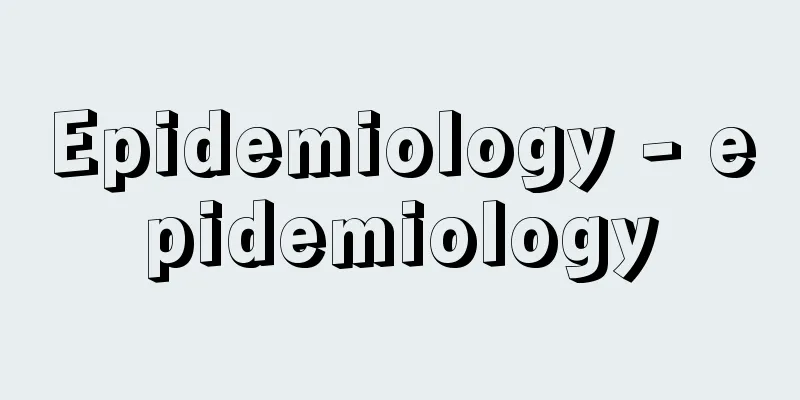Epidemiology - epidemiology

|
It is a science that investigates the causes of diseases by observing the occurrence and distribution of diseases in human populations. Medical research aimed at overcoming health disorders in humans can be broadly divided into three fields: clinical medicine, experimental medicine, and epidemiology. Clinical medicine mainly focuses on cases to investigate the mechanism and course of disease and to study treatment methods. Cases are formed when subjective or objective symptoms first appear, and most people who seek medical treatment do so on their own initiative, which can be said to be a highly biased subject for medical research. Experimental medicine, which is favored by basic medical scientists, aims to objectively clarify the causes and mechanisms of diseases, but in most cases, this is done on animals, and even if the animal experiments are scientifically managed, it is dangerous to immediately extrapolate the results to humans. Moreover, the experimental sites are artificial and often in extreme environments that are very different from natural conditions. For example, high concentrations of a substance that would not occur under natural conditions are administered to experimental animals to study its carcinogenicity, but it is difficult to directly apply this to the real world. On the other hand, as mentioned above, the subject of epidemiological research is human populations. Because clinical medicine focuses on cases, it can be said to study only the "numerator" of a fraction, whereas epidemiology looks at diseases that occur in human populations, and so can be said to study both the "numerator" and the "denominator." Also, while experimental medicine is conducted in a planned manner under artificial conditions, mainly on laboratory animals, epidemiology looks at diseases that occur naturally in naturally occurring human populations, and so can be said to be an "accidental human experiment." Take, for example, research into the relationship between drunk driving and traffic accidents. In human experiments in experimental medicine, researchers give people alcohol and have them drive on a race circuit, whereas in epidemiology, researchers study whether people who voluntarily drink alcohol drive on public roads and cause traffic accidents. Even in cases where the cause of a disease has been clearly established, such as the relationship between radiation and leukemia, answering the question of whether working for many years at a nuclear power plant causes leukemia is impossible without research on a group of people who have worked at that nuclear power plant for many years, that is, epidemiological research. [Minoru Sugita] History and research content of epidemiologyIn 19th century London, before the cholera bacterium was discovered, J. Snow pointed out that a certain well was contaminated with the pathogenic substance that causes cholera after many cases of cholera occurred among people who drank water from that well. He proposed a ban on the use of that well's water, which was effective. As this example shows, historically, epidemiology has been an effective science in reducing infectious diseases by identifying and eliminating the causes. However, in recent years, as infectious diseases have decreased and lifestyle-related diseases (adult diseases such as cerebrovascular disease, cancer, heart disease, etc.) have increased relatively, the focus of epidemiology has shifted to lifestyle-related diseases. The significance of epidemiology lies in observing diseases, elucidating their causes, and eliminating them to reduce the incidence of the disease. However, in reality, elucidating the causes and eliminating them are quite difficult problems. This is shown by the fact that even after it was discovered that tuberculosis is caused by the tuberculosis bacillus, the disease tuberculosis did not decrease so easily. The presence of the tuberculosis bacillus does not necessarily mean that one will develop tuberculosis, and even if it is said that the tuberculosis bacillus should be eliminated, it is actually impossible to do so completely. Generally, diseases occur as a result of a complex intertwining of three factors: (1) a cause such as a pathogen, (2) the person who suffers from the disease, and (3) the environment that connects the two. Therefore, the cause of a disease that epidemiology seeks to elucidate must include the relationship between these three factors. For example, in the case of tuberculosis, it is necessary to consider the nutritional status of people, the economic state of society, and the crowded living space, and in the case of Japanese encephalitis, it is necessary to study the occurrence of Culex pipiens mosquitoes, which carry the virus, as well as other factors. [Minoru Sugita] Order of epidemiological studiesThere are three stages in epidemiological research: (1) descriptive epidemiology, (2) hypothesis setting, and (3) analytical epidemiology. Descriptive epidemiology aims to set a hypothesis about the cause of a disease by investigating who (by sex, age, and occupation), when (time), and where (space) is affected, and what kind of disease is more or less common. For example, in 1955 (Showa 30), an unprecedented disease spread in a fishing village in Minamata City, Kumamoto Prefecture. This was investigated in the descriptive epidemiology stage, and a hypothesis was set that the cause was likely marine products from Minamata Bay (hypothesis setting). The next stage, analytical epidemiology, aims to prove the relationship between the hypothesized cause and the disease. There are two main methods of analytical epidemiology: the case-control method and the cohort method. The case-control method is a method of comparing a group of patients with a certain disease with a control group without the disease to see if the patient group has a high incidence of an event that is likely to be the cause of the disease. On the other hand, the cohort method is a method of observing a group with an event that is likely to be the cause of the disease and a group without it to see if the disease occurs more frequently in the group with the event. One example of analytical epidemiology is the attempt to prove the relationship between lung cancer and smoking as a hypothetical cause, which has resulted in a strong relationship being proven between the two. [Minoru Sugita] Epidemiological causationEpidemiological causation refers to whether or not a relationship proven by analytical epidemiology is a causal relationship. For example, in analytical epidemiology, it is not impossible to conclude that public telephones have some kind of relationship as a hypothesis for the cause of lung cancer (this was an erroneous result that occurred because the disturbing factor of economic growth was not removed). However, it is obvious from medical common sense that this relationship is not a causal one. Therefore, for something to be generally accepted (proved) as an epidemiological causal relationship, the following six conditions must be met: [1] "The relationship always exists" in which similar conclusions can be reached even with different research methods. [2] The strong degree of relationship, i.e., a group that has the factors for a certain disease has a higher incidence of that disease than a group that does not have those factors. [3] The unique relationship is that many people have both the disease and its underlying causes at the same time. [4] The existence of a causative factor precedes the onset of a disease in time; that is, the relationship is not temporally contradictory. [5] "The relationship is consistent" in that it conforms to medical and biological principles. [6] There is a "dose-response relationship" in which the more of the factor a group has, the more likely it is to suffer from the disease. Only when all six of these conditions are met can an epidemiological causal relationship be generally accepted. [Minoru Sugita] Source: Shogakukan Encyclopedia Nipponica About Encyclopedia Nipponica Information | Legend |
|
人間集団に発生分布する疾病を観察して、その疾病の原因を究明する学問である。人類の健康障害を克服することを目的に行われている医学研究は、大きく三つに分けられる。それは臨床医学、実験医学、疫学の3分野である。臨床医学は、主として症例を中心として疾病の機序(メカニズム)や経過を調べ、治療の方法を研究するものである。症例は自覚的あるいは他覚的症状がまず出現し、診療を求めてきた者の大部分は自ら進んできた者であり、これは医学研究の対象としては著しく偏ったものといえる。また、基礎医学者などが好んで研究する実験医学は、疾病の原因や機序の解明などを客観的に行うものであるが、普通の場合これは動物を対象とすることが多く、いかに科学的に管理された動物実験でも、その結果をただちに人間に類推することには危険を伴う。しかも実験の場が人為的であり、極端な環境下で、自然の条件とは非常に異なっている場合も少なくない。たとえば、自然の条件ではありえないような高濃度の物質を実験動物に投与して、その発癌(はつがん)性を研究するなどで、これをそのまま人間の実社会に応用することは困難である。 一方、疫学研究の対象は、前述したように人間集団である。臨床医学が症例を対象とすることから、分数に例えるなら「分子」のみに関する研究であるといえるのに対し、疫学は人間集団に発生する疾病をみることから、「分子」と「分母」の両方に関する研究であるといえる。また、実験医学が人為的条件下で主として実験動物を対象に計画的に行われるものであるのに対し、疫学は自然に存在する人間集団に自然に発生する疾病をみることから、「図らずも行われた人体実験」ともいうことができよう。 例として、飲酒運転と交通事故の関係を解明する研究をあげよう。実験医学における人体実験では、人に酒を飲ませてサーキット内で運転させる研究方法をとるのに対し、疫学では、本人の意志で飲酒をした者が一般道路で運転して交通事故をおこすかどうかを調査するという研究方法をとるわけである。また、放射線と白血病の関係のように、疾病の原因としてはっきり解明されている事象でも、ある原子力発電所で長年作業することが白血病をおこすかどうかという命題に答えるには、その原子力発電所で長年作業した人間集団を対象とする研究、つまり疫学としての研究がなければ不可能なわけである。 [杉田 稔] 疫学の歴史と研究内容コレラ菌がまだ発見されていない19世紀のロンドンで、スノーJ. Snowは、ある井戸の水を飲んだ人々に多くのコレラが発生したことから、その井戸がコレラの病原物質で汚染されていると指摘し、その井戸水の使用禁止を提唱し、効果をあげた。この例にあるように、歴史的にみると疫学は伝染病の原因を解明し、その原因を除去することにより、伝染病の減少に有効な学問であったといえる。しかし最近では、伝染病の減少とともに生活習慣病(成人病=脳血管疾患、癌(がん)、心臓病など)の相対的増加により、疫学の対象の比重が生活習慣病に移ってきている。 疫学は疾病を観察して、その病因を解明し、それを除去することにより、その疾病を減少させることに意義があるわけであるが、病因解明とその除去は実際にはかなりむずかしい問題である。結核の原因は結核菌であることが解明されても、結核という疾病はそう単純には減少しなかったということが、それを示している。結核菌があれば、かならず結核になるというものでもないし、単純に結核菌を除去すべきであるといっても、それを完全に行うことは実際には不可能なことである。一般に疾病とは、(1)病原菌のような病因、(2)疾病に罹患(りかん)する人間、(3)両者を結ぶ環境の三者の関係が複雑に絡み合って発生するものである。したがって疫学において解明されるべき疾病の原因は、その三者の関係をも含むものでなければならない。たとえば、結核では人間の栄養状態、社会の経済状態、生活空間の混雑などの考察が必要であり、日本脳炎ではそのウイルスを運ぶアカイエカの発生状態などをも含めて研究されなければならないわけである。 [杉田 稔] 疫学研究の順序疫学研究を進める順序としては、(1)記載疫学、(2)仮説設定、(3)分析疫学の3段階がある。まず記載疫学は、だれが(性、年齢、職業別)、いつ(時間的)、どこで(空間的)、どのような疾病に、多くあるいは少なく罹患しているかを調べることにより、その疾病の原因であろうと考えられる事象を仮説として設定することを目的としている。水俣(みなまた)病の例をあげるならば、1955年(昭和30)ごろ熊本県水俣市の漁村にそれまでに例をみない病気が流行している。これを記載疫学の段階で、まず調査し、この原因は水俣湾産の水産物らしいという仮説が設定される(仮説設定)。次の分析疫学は、仮説として設定された病因らしき事象と疾病との関係を証明するものである。この分析疫学には大きく分けて、症例対照法とコーホート法という二つの方法がある。症例対照法は、ある疾病の患者群と、その疾病でない対照群とを比較して、患者群が病因らしき事象を多くもっているかどうかを調べる方法である。一方、コーホート法は、病因らしき事象をもっている群とそうでない群とを観察して、それをもっている群にその疾病が多く発生するかどうかを調べる方法である。分析疫学の一つの例として、肺癌とその病因の仮説としての喫煙との関係を証明しようとする場合があげられ、結果として両者の強い関係が証明されている。 [杉田 稔] 疫学的因果関係疫学的因果関係とは分析疫学で証明された関係が、因果関係であるかどうか、ということである。たとえば、分析疫学において、肺癌とその病因の仮説として、公衆電話がなんらかの関係をもつという結論も導けないことはない(これは、経済成長という攪乱(かくらん)要素を除去しなかったためにおこった誤った結果であった)。しかし、この関係が因果関係でないことは医学的常識から当然のこととして理解できる。そこで、疫学的因果関係として一般に受け入れられる(証明)には、次の六つの条件を備える必要があるとされている。 〔1〕異なった研究方法でも同様な結論であるという「関係がつねに存在すること」。 〔2〕ある疾病の要因をもっている群は、それをもたない群に比べてその疾病の発生率が高いという「関係の程度が強いこと」。 〔3〕疾病とその要因を同時に両方とももっている人が多いという「関係が特異であること」。 〔4〕要因の存在は疾病の発生より時間的に先行するという「関係が時間的に矛盾しないこと」。 〔5〕医学生物学的な筋道と一致しているという「関係が首尾一貫していること」。 〔6〕その要因をより多くもっている群ほどその疾病により多く罹患するという「量反応関係であること」。 以上の六つの条件のすべてが満たされて、初めて疫学的因果関係が一般に受け入れられるわけである。 [杉田 稔] 出典 小学館 日本大百科全書(ニッポニカ)日本大百科全書(ニッポニカ)について 情報 | 凡例 |
Recommend
Stone pot - Ishigama
〘 noun 〙 A salt-making pot made of river stones or...
Genus Austrocedorus
...The subfamily Cupressaceae includes species su...
Shimokawabe Yukihira
Years of birth: Years of birth and death unknown. ...
Bernard Silvestre
…an early French scholastic philosopher and membe...
Aung San Suu Kyi - Aung San Suu Kyi
Myanmar political leader. Born in Yangon (formerly...
neolithic revolution
…Of the three transitions mentioned above, the Br...
King of England
…In addition to the Church of England, there are ...
Papanin - Papanin (English notation) / Ivan Dmitrievich Papanin
Soviet Arctic explorer, scientist, and admiral. H...
Cowshed - Gyusha
〘 noun 〙 A shed for keeping cows. A cowshed. ※Aoga...
Auber
French composer. He was good at composing from an ...
Discounted marriage - Kassankon
...In the old Chinese marriage system, which requ...
Bartholin, C.
…The great vestibular gland is also called glandu...
Asset Consolidation System - Shisan Gasanseido
In principle, income tax is levied on individuals,...
Namibia - Namibia (English spelling)
A republic in southwestern Africa. Formerly known...
Dialkyl peroxide - Dialkyl peroxide
...Many metal peroxoacid salts, such as peroxochr...









